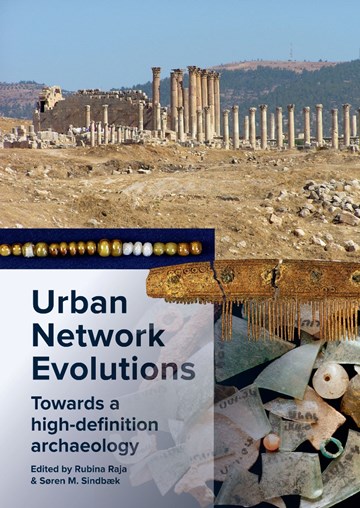Review of: R. Raja & S. M. Sindbæk (eds), Urban Network Evolutions. Towards a High-Definition Archaeology (Aarhus: Aarhus Universty Press)
Review in Bryn Mawr Classical Review by Matthew Selheimer (University of Leicester).

M. Selheimer. (2020). "Review of: Rubina Raja, Søren M. Sindbæk, Urban network evolutions: towards a high-definition archaeology. Aarhus: Aarhus University Press, 2018. 309 p.. ISBN 9788771846232", Bryn Mawr Classical Review 2020.05.12.
From the review (focusing on the chapter ‘Jerash: From Roman to Islamic City’):
"The third chapter reviewed in depth here is from the section on Jerash: ‘Small change in big cities: Characterising the development of everyday coinage in Jerash’ by Thomas Birch and Vana Orfanu. This chapter discusses the analysis of a sample drawn from 800 small copper-based coins, so-called minimi, representing the Roman to the early Islamic period and found during the 2012-2016 excavations of the Danish-German Northwest Quarter Project. Per the authors, chemical analysis shows coins containing 5% or more lead content increased significantly from the 4th to 5th centuries CE. During the Byzantine period that followed, the leaded coin percentage dropped. As Umayyad coinage appeared, leaded coins further dropped and then later rose again sharply. According to the authors, this change in the composition of the coins indicates debasement and/or restricted access to copper, which may also indicate instability and socio-economic changes taking place in the city over time. The authors conjecture this may be related to historical events such as the “stripping of pagan temples or state-spending during the Justinian period”, but that samples from other cities in the region are needed to determine if the pattern is observed more broadly (p. 120). Finally, the authors indicate microscopic analysis shows the coins were very likely cast with smooth obverse and reverse sides (i.e. no figural representations or legends) as they “lack any surface detail” (p. 121). They believe this may indicate a locally manufactured currency that imitates ‘real’ minimi.
The other chapters in this section also relate to the results of recent Danish research projects in the city, specifically the results from the Danish-German Northwest Quarter Project. These chapters discuss findings, such as differential street paving as compared to the city center, the dating of water system features in the area, a slow change in household pottery after the Arab conquest, the remelting and reshaping of glass in the early Islamic Period, the chemical composition of mortars and plasters produced in the city, wall painting techniques and pigments that demonstrate a high degree of continuity in their style from the late Roman to early Umayyad periods, the heavy use of locally-produced pottery across all categories common in daily use from the Roman to the Byzantine to the Early Islamic periods and possible scenarios to explain this phenomenon). An additional chapter in this section proposes socio-economic change as evidenced by a reduction in the maintenance of agricultural terraces along the nearby river. This section and its chapters will be of interest to those scholars studying the Roman eastern provinces, specifically the site of Jerash, and the transition from the Roman to Byzantine to Islamic periods."
